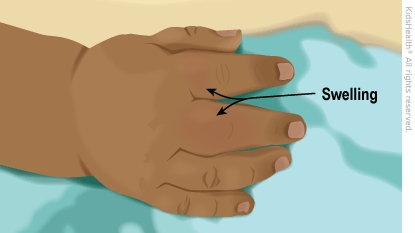Sickle cell dactylitis is a painful swelling of the hands and/or feet. It can start suddenly and last about 1–2 weeks. The pain and swelling of dactylitis (dak-teh-LIE-tis) can come and go, but kids with sickle cell disease usually stop getting it by around age 3. Follow these instructions to care for your child at home.


For pain:
Keep your child healthy:

Your child:
You know your child best. If you feel they're not well or something is wrong, call your hematology team.

Your child:
Tell emergency responders that your child has sickle cell disease.

What is dactylitis? Dactylitis is often the first type of pain that a child with sickle cell disease gets. It is a painful, temporary swelling of the hands, the feet, or both.
Dactylitis is sometimes called hand–foot syndrome. It happens because sickle-shaped red blood cells don't move smoothly through blood vessels. They can stick together and clog the blood vessels inside the hands or feet.

How can I tell if my child has dactylitis? When blood vessels are clogged, the bones of the hands or feet sometimes don't get all the blood and oxygen they need. Blood also might build up in the veins. This leads to pain and swelling. A child's skin may look red. Some kids have a fever.
Can pain episodes like dactylitis be prevented? To help prevent pain episodes like dactylitis, make sure your child gets plenty of rest and drinks lots of liquids to avoid dehydration. Also, help them to not get too cold or too warm.